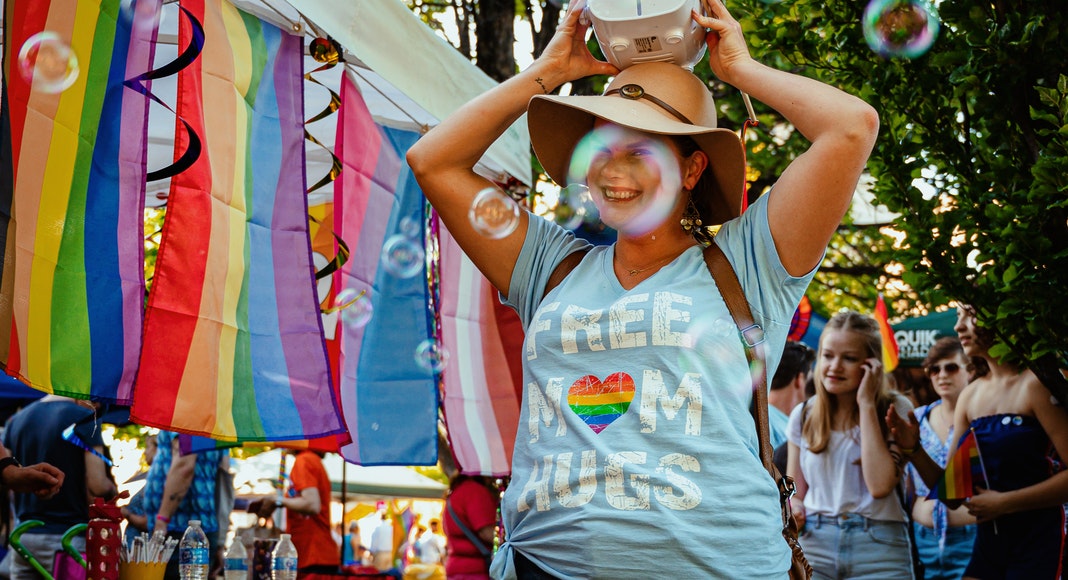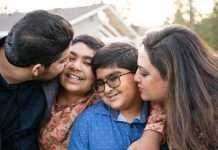 I recently interviewed Chris Tompkins, a teacher, TEDx speaker, spiritual life coach, and LGBTQ inner-advocate based in Los Angeles, California. Perhaps more importantly, he’s an uncle of five. Chris believes all kids are the future and teaches social-emotional learning throughout Southern California.
I recently interviewed Chris Tompkins, a teacher, TEDx speaker, spiritual life coach, and LGBTQ inner-advocate based in Los Angeles, California. Perhaps more importantly, he’s an uncle of five. Chris believes all kids are the future and teaches social-emotional learning throughout Southern California.
For Chris, no matter who we are or where we come from, we all play on the same playground. There are certain collective societal messages we hear growing up that we either consciously or subconsciously believe. As a result, we develop certain belief systems from which we operate our lives. Chris’ book, Raising LGBTQ Allies, sheds light on the deeper, multi-faceted layers of homophobia.
Tracy (SFBAM): What is an LGBTQ Ally?
CHRIS: An LGBTQ ally is someone who demonstrates their allyship through action.
One of my favorite ways to distinguish the difference between active and passive allyship is by looking at the difference between proactive and reactive behavior.
Put simply, when we’re emotionally and mentally prepared before we enter a situation, we’ll be less reactive if it doesn’t go our way. The concept makes sense for matters pertaining to life, work, and relationships. But what about how we engage children?
When it comes to proactive parenting, or being an active LGBTQ ally, it’s important that we explore the reasons why we choose, consciously or not, to avoid certain conversations. Oftentimes, the topics we don’t like to talk about are the ones we don’t understand, are uncomfortable bringing up, or avoid having. Hidden in our avoidance is an aversive belief, shame, bias, or fear, including the fear of offending and the fear of failure.
The world is changing at a rapid pace and unfortunately, it’s not enough to be a passive ally for the LGBTQ community. We have to become willing to prevent heteronormativity, homophobia, and transphobia from taking root at home, in the classroom, and on the playground by proactively taking action and demonstrating our allyship by having open and honest conversations with young people.
Just like physical exercise, unless we do the work, we won’t see the results. By consciously committing to active allyship, we begin the first step to improving the world for the next generation.
A few questions you can ask yourself to gage your level of active allyship are:
- What am I doing to prepare my children for the new world in which they’ll live?
- What proactive action am I taking to inject an expanded awareness into my child’s life?
- How am I intentionally, mindfully, and actively raising allies?
- How am I accounting for the gender and sexual diversity of all youth?
- If I don’t know how to have conversations about gender and sexuality, is there a person or an organization I feel comfortable learning from?
By stepping into the role of active allyship, we prevent queerphobia and bullying before they begin. We also help raise new generations of LGBTQ allies.
TRACY (SFBAM): When should we start having conversations with our children around LGBTQ/sexual identity? And what does that “look” like for elementary kids? middle school kids? high school kids?
CHRIS: One of the things I invite parents and caregivers to consider is that this isn’t a “one time” or a “one-size-fits-all” conversation. It’s an ongoing conversation that will change and look different depending on the context and child’s age.
For elementary-age kids, I often tell parents and caregivers that if children are asking questions, they are old enough to learn the answers. There are, of course, age-appropriate ways of answering, but a child’s curiosity is usually a good indication that they’re ready.
In chapter 4 of my book, I give a comprehensive breakdown of children’s sexual and gender identity development. Like most things when it comes to children, though, each child is unique and so how we engage with one may look different than how we engage with another. What’s important to consider is that by having conversations with children at a young age, we help them to see gender and sexuality as sacred. It teaches them to respect, honor, and value their gender and sexual identity—gay, bisexual, straight, asexual, transgender, cisgender, or non-binary.
A lot of the youth I work with aren’t informed or educated about relationships, including sex, sexuality, and gender. In fact, most LGBTQ youth learn about sex through gay porn because of the lack of education. By the time a child is twelve, they will have already seen or have been shown pornography. Most youth in general aren’t having educated conversations with parents or caregivers so the internet is the only place for LGBTQ youth to go.
A mom I know recently told me that when she brought up gender and sexuality with her fourteen-year-old son, he said, “Mom, you’re weird.” She asked me what she should do. I told her it’s a normal response for a lot of teenagers, but it doesn’t mean we stop talking about it.
The more we’re able to have healthy conversations with our children, the more we affirm their identity, whatever it may be. We also help normalize all gender and sexual identities.
TRACY (SFBAM): How should parents support their child if their child questions their sexuality?
CHRIS: Language is important. In fact, it’s the focus of chapter 2 in my book. Often the words we say reflect our subconscious beliefs. My first invitation would be to try and see their child as discovering their sexuality.
The best way we can support a young person in discovering their sexuality is to listen without offering advice and to validate their experience. Sometimes youth just want to be heard and to know that they have someone with whom they can trust. Parents can support their children by giving them the space to discover themselves.
Regardless of a young person’s sexuality, self-discovery is nuanced and can be tricky. Providing a safe space, letting a child know they can talk to you (even when they say they don’t want to), and validating their experience is the best way we can support their process.
And it’s okay, by the way, if you don’t know what to do, what to say, or if you don’t feel prepared. Parenting is no easy feat. The good news is that you don’t have to take this journey alone. If you don’t know, ask for guidance and follow your heart. There are many wonderful groups and books out there.
TRACY (SFBAM): What organizations/resources are available to help parents navigate having an LGBTQ child?
CHRIS: In chapter 10 of my book, I offer resources for parents, caregivers, and teachers to help them raise LGBTQ allies and navigate having an LGBTQ child. A few national groups I recommend for parents, teachers, and allies are:
Each of these organizations provides free online information on how to advocate and be an ally for LGBTQ youth. No matter where you find yourself, these organizations can help.
TRACY (SFBAM): What if a parent is LGBTQ? How/when should they have conversations that address their own sexuality?
CHRIS: I love this question and I think it’s a really important one. The best way for an LGBTQ parent to talk to their children about their own sexuality is by having proactive conversations. Because we live in a heteronormative world, it’s not enough for LGBTQ parents to skip conversations around gender and sexual identity differences.
This isn’t about making youth hypervigilant about differences; it’s about instilling in them a sense of awareness about the diverse world in which they live.
Kids pick up on their surroundings and there will be a moment, conscious or unconscious, that an LGBTQ parent’s child will begin to notice the differences in their family structure.
Whether it has to do with socioeconomic status, adoption, race, gender, divorce, or sexuality—there are many ways of being a family. But our silence is loud and can often be misinterpreted as fear, judgement, or shame. When we give children language for what they’re naturally internalizing from their surroundings, we help prevent any fear, judgement, or shame from taking root inside their belief system.
Chris Tompkins is a teacher, TEDx speaker, spiritual life coach, and LGBTQ inner-advocate based in Los Angeles, California. More importantly, he’s an uncle of five. Chris believes all kids are the future and teaches social-emotional learning throughout Southern California.




















